The Power of Objects
Tamar MacLellan, UK
Tamar MacLellan is an artist teacher and part-time collaborator with The Caseroom Press at the University of Lincoln. Employed as Head of Creative Arts at Oxford Tutorial College, current research investigates the construction of knowledge through collaborative pedagogy with undergraduate and A Level students in order to extend learning beyond the classroom and inform curriculum development.
Menu
Introduction
Background
Lesson outline: Lesson 1
Lesson outline: Lesson 2
Lesson outline: Lesson 3
Conclusion
References
Artist references
Drawing upon my own visual arts practice I have developed a series of practical lessons which enable students to produce individual responses to everyday objects. Beginning with a series of questions which prompt verbal, visual and written analysis, students are enabled to make use of increasingly more individual and meaningful media and styles of mark-making within their visual arts practice. Outcomes produced intertwine written and drawn annotations offering new approaches for making work. Within the first lesson all students are invited to consider a series of questions to uncover the agency of everyday objects within their possession. Specific questions generate greater levels of engagement amongst the student group which offers the potential for individual lines of enquiry to be explored and unique outcomes to be developed at differing stages throughout the lessons. As this happens students begin to more purposefully lead their learning and construct their own questions which leads to greater levels of autonomy and ownership around the refinement of their work.
My initial training in Textiles provided the opportunity to explore colour, pattern and scale within fashion, interior and fine art outcomes which fostered a love of shapes which connect, interlock or overlap. Recently I have made work in response to the shapes and patterns found in every day domestic objects. Whilst observing these forms I have begun to consider their role in my life, how long I have owned them, who gave them to me and on what occasion. Drawing upon the writing of Sherry Turkle (2011) and notions of Bricolage, I have come to understand the power of objects to provide ideas, enable the combination of a diverse range of starting points and inform the development of wide ranging visual art practice. It is this ‘providing of ideas’ which became the basis for the development of this series of lessons which aim to facilitate the use of a broader range of media and mark making alongside higher levels of autonomy and individuality in outcomes produced.
The first lesson begins with all students being asked to examine the contents of their bag, pockets, purse or wallet. This could take the approach of a forensic examination with each object placed within a grid on a table or singular objects considered in turn. Students can choose to examine these through writing descriptions, drawing shapes and sections or photographing alternative viewpoints. Similar objects may be found within each students’ bag and objects such as text books, pencil cases and house keys may provoke conversation amongst the student group and the sharing of associated memories. Students should be encouraged to record all initial additional lines of enquiry so that these can be reviewed and possibly made use of at a later stage.
Following this first initial examination, students are asked to select just one object and follow its associations. This may include descriptive drawing or writing providing factual and observational information about shape, size and colour. To encourage this process, tutor directed questions may request an examination of shape, form and materiality in addition to reflective analysis examining how long the student has had the object, who gave it to them and why. In this way remembered memories are recorded alongside factual information which provides opportunities for multiple responses and enables engagement with a range of art making styles. Written and drawn annotations begin to construct a detailed biography of the chosen object and at this stage individual students may choose to, or be encouraged to, extend the media they are using in order to produce more meaningful individual outcomes.
At this stage of the lesson students often begin to develop individual lines of enquiry. Objects chosen begin to remind them of significant people, places or events in their life which can provide the opportunity for a change in direction of working. Students should be encouraged to list all ideas as they occur. Whilst some students will make their own connections with ease and begin to link ideas and styles of working others may need additional prompts as the first lesson draws to a close. Students can be encouraged to review their work and list the objects drawn, associations made and materials explored in order to uncover common themes and make connections which they are interested to develop further. Visual examples gathered from the work of practicing artists who make use of test and image within their own practice may provide additional support to encourage, facilitate and extend student ideas
The first lesson should conclude with all students being able to select which objects they will examine in the next class and why. Encouragement should be given for students to search out objects with meaning and significance in order to extend the range of individual responses produced. This may require students to bring in new objects, undertake reading and research prior to the next class and / or gather new media to make use of.
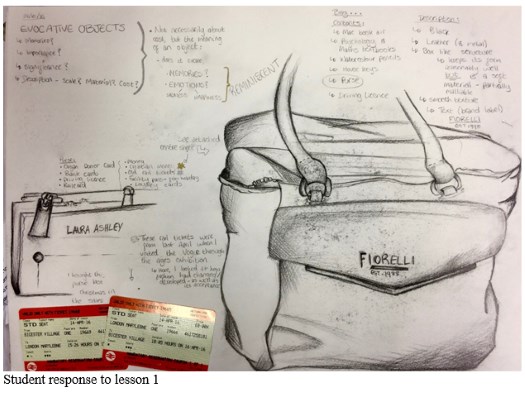
The second lesson begins with each student documenting the object or objects they have selected to bring into class in response to their first ideas. The group may be asked to list characteristics, associations and record factual information and could be encouraged to work through a series of questions at the same time. In this way, all students can produce work at the same pace responding to their individual objects. Alternatively, students could choose to take increasing ownership of the development of their work throughout this second class and be facilitated to work independently making individual choices about how and why they draw. Direct questions to encourage the use of meaningful colour responding to the role of the object or significant people connected to the object can support students who are hesitant about the development of their work. Students could make use of significant individual letters, words or phrases as they draw their objects so that the form and structure is constructed through the linking of these letter forms. Further development with text could lead to the inclusion of remembered memories or stories about the objects which could be overlapped, combined and placed within the same artwork. At this stage students, can be encouraged to share their developing individual ideas with their peers and tutors in order to clarify which idea they want to develop further and why. Experimentation should be encouraged at this stage so that one idea is trialed in a number of different media in order to develop effective and meaningful mark making to most effectively represent the character and significance of each evocative object.
The second lesson should conclude with all students constructing their own series of actions for the final class. Consideration can be given to which surfaces they will draw on and why, what they will draw with and why, which colours they will use and why and at what scale they will work and why. Prompts may be given to support this process such as where does the object usually live in their house or bag? How long have they owned the object? Where did they get the object? Examples of the work of relevant practitioners will put this part of the project into context and may also support the decision-making process around choice of media and styles of mark making
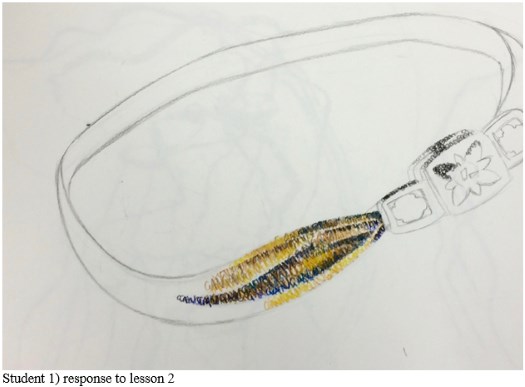
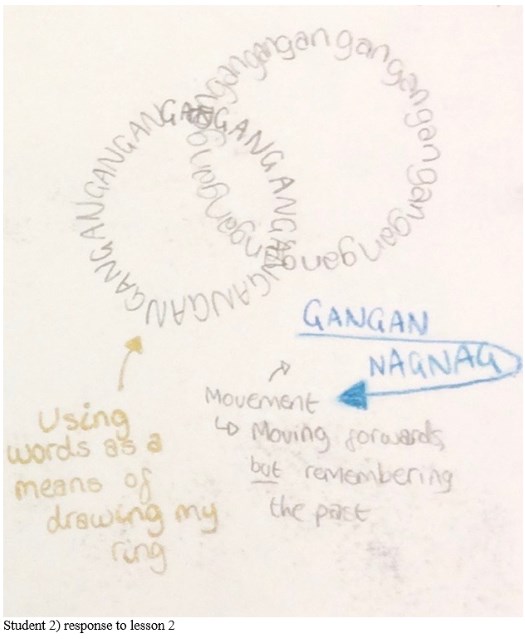
Having generated, and reflected upon, a range of responses within lesson 1 and lesson 2 students may be in a position to completely lead their learning within this final lesson with individual and significant work to self being constructed. Individual lines of enquiry may be returned to; tangent ideas may be explored and new objects will provide further breadth and depth to styles of working. Individual work should be very much supported and at this stage the teacher may become a technician and only required to search out new and relevant materials to be used in the art making process. Some students may require prompts and further encouragement throughout the lesson. These can take the form of a list of questions to be worked through at the individuals’ pace or directed time bound challenges to encourage the process of taking an idea for a walk with one word leading onto the next. This may include encouraging students to record ideas about family members or friends and to extend the range of written words linked to their chosen object. Consideration can be given to how they are connected to the object and encouragement can be given to the idea of research through discussion and how objects are represented and why.
As students move towards producing more refined outcomes students may be encouraged to think through all aspects of their work so that a greater degree of meaning making emerges within their visual arts practice. Individual outcomes may be constructed from a range of materials which may include: stitch, tape, found surfaces, relief print, rubbings and wire.
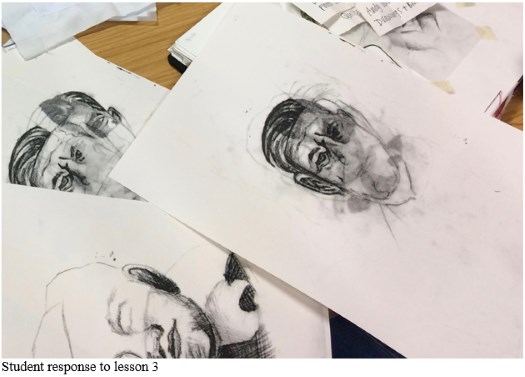
Whilst this series of lessons begins with all students working at the same pace and responding to a very similar series of objects, students become engaged and begin to construct very individual lines of enquiry at differing times throughout each of the three lessons. I have found that I need to be prepared to change the order of each lesson – perhaps slow down and give greater time for students to fully follow the associations of the objects they have selected, or bypass a stage, or extend further discussion and verbal analysis which may enable the agency of objects to be uncovered. This variety of approach to lesson delivery provides the opportunity for all students to value the worth in their ideas, lead their learning choices and produce individual outcomes. Some students may require a greater number of directed questions whilst others may require just one vague prompt. Although examples of others work are very helpful to provide further confidence and assurance for students who may be hesitant about the quality of their own emerging lines of enquiry I try to resist sharing these with the group until individual ideas have been formed. In this way it is the objects which become significant and provide ideas. Whilst working with students I have encouraged the uncovering of ‘real’ object biographies so that students’ begin to make visual art work with greater meaning and personal significance. This has led to the achievement of high grades within both A Level Art, Textiles and Photography final outcomes and undergraduate courses. Within my own work I have begun to construct ‘imagined’ histories of objects to inform the making of work and I am interested in taking this approach with students in future classes. In this way connections can be made to found objects perhaps those ‘rescued’ from charity shops or car boot sales and value attached to them through this same process of working.
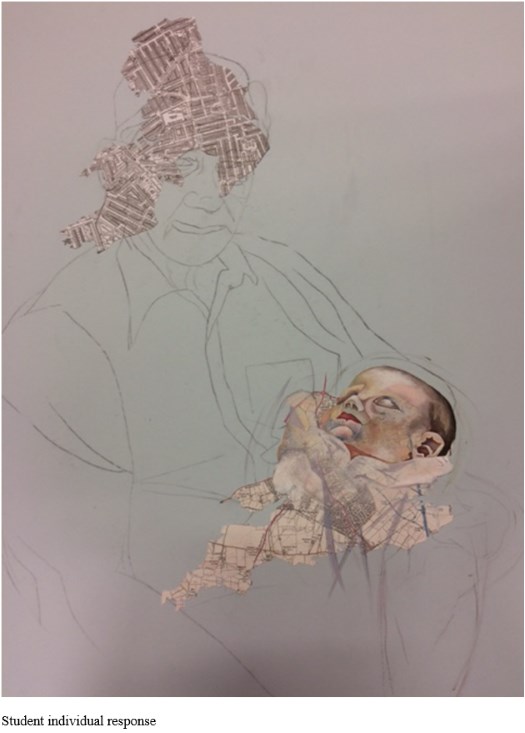
Collins, H. (2010) Tacit and Explicit Knowledge, Chicago: University of Chicago Press
Ingold, T. (2007) ‘Materials against materiality’, Archaeological Dialogues, 14, 1, 1-16
Tilley, C. (2007) ‘Materiality in materials’, Archaeological Dialogues, 14, 1, 16-20
Turtle, S. (2011) Evocative Objects: Things We think With, Cambridge, Mass: The MIT Press
Wood, A. (2014) I Have Only What I Remember, England, Magic Bird Press
Cos Ahmet
Louise Baldwin
Caroline Broadhead
Michael Craig-Martin
Victoria Crowe
Tim Davies
Dawn Dupree
Steve Edwards
Sally Grumbridge
Michelle House
Matthew Harris
Jonah Jones
Tilke Schwatz
Cy Twombly

Please check the Teaching Multiple Intelligences course at Pilgrims website.
Please check the Creative Methodology for the Classroom course at Pilgrims website.


|